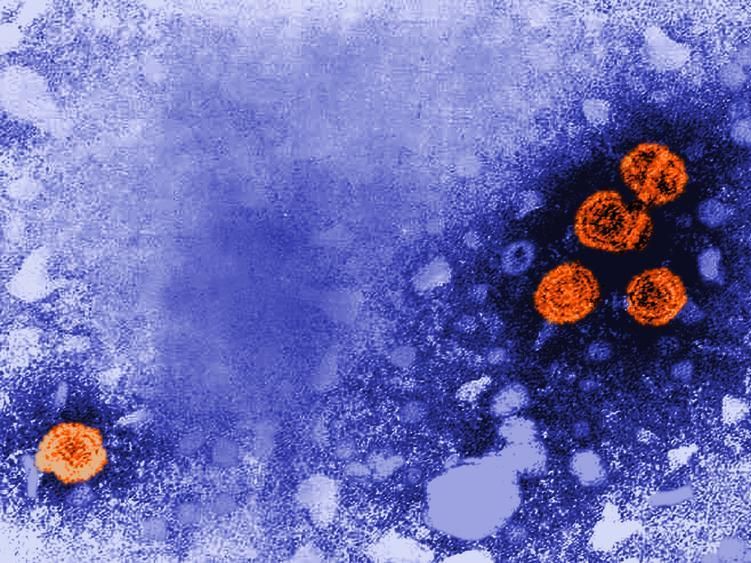New combination therapy offers chance of curing hepatitis B
Advertisement
Around 260 million people, more than three percent of the world's population, are chronically infected with the hepatitis B virus (HBV); in the long term, this often leads to complications such as cirrhosis of the liver or liver cancer. A cure is not yet possible with existing drugs. Scientists at the German Center for Infection Research (DZIF) and the University Medical Center Eppendorf (UKE) have now found a combination therapy that shows high efficacy in the model.

Hepatitis B virus particles stained orange; electron micrograph.
cdc/Dr. Erskine Palmer
The new therapeutic approach is based on silencing the viral hepatitis B genome, which is located in the nucleus of infected liver cells. After infection of the liver cell, the viral genome in the cell nucleus is converted into a closed DNA ring molecule. This deoxyribonucleic acid is a stable, so-called covalently closed circular DNA (cccDNA), which serves as a template for the production of new viruses. The cccDNA is the central reservoir of the hepatitis B viruses and enables them to survive in the liver. The virologist Prof. Dr. Maura Dandri and her team at the UKE were able to prevent the HBV cccDNA from producing further viruses in an animal model.
The target of their therapy is the viral protein HBx, which protects the ring-shaped HBV DNA in the cell nucleus from silencing by preventing a host-specific factor (SMC complex) from binding to it. On the one hand, they treated the animals with the antiviral cytokine interferon-alpha, an endogenous substance of the immune system; on the other hand, they suppressed the formation of the protein HBx by RNA interference, a method in which the conversion of RNA into protein is hindered. In both cases, they were able to reduce the HBx concentration and thus silence the cccDNA. They additionally combined this treatment with the administration of Bulevirtide, which can prevent the viruses from entering the cells and thus re-infecting them. In this way, the effect of cccDNA silencing was maintained even after treatment ended. Bulevirtide, better known under the research name Myrcludex, was co-developed at the DZIF and recently approved as an active agent against hepatitis D on the European market.
"This combination therapy was able to sustainably silence the cccDNA in the nucleus," explains Prof Dandri. She heads the "HBV Cure" project at the DZIF and the "Viral Hepatitis" working group at the UKE. Even though it has only been tested in the mouse model so far, Prof Dandri is convinced of the combination: "These results show that the HBV genome can be switched off with certain combination therapies. These approaches can now be applied in clinical trials to achieve a functional cure for chronic hepatitis B."
Note: This article has been translated using a computer system without human intervention. LUMITOS offers these automatic translations to present a wider range of current news. Since this article has been translated with automatic translation, it is possible that it contains errors in vocabulary, syntax or grammar. The original article in German can be found here.



























































